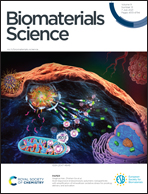Linear and high-molecular-weight poly-porphyrins for efficient photodynamic therapy†
Abstract
Photodynamic therapy (PDT) holds great potential in cancer treatment due to the advantages of non-invasiveness, negligible side-effect, and high spatiotemporal selectivity. Porphyrin is the most widely used photosensitizer in clinical treatment. However, its PDT efficacy is always limited by the undesired aggregation caused quenching (ACQ) effect originating from the planar and rigid structure. In this work, a linear polymeric porphyrin with “structure defects” was developed to overcome the ACQ effect for most of the photosensitizers with conjugated macrocycles. Compared to porphyrin monomers, poly-porphyrins could improve singlet oxygen generation ability, and the singlet oxygen quantum yield enhanced with increasing molecular weight of poly-porphyrins. To achieve efficient in vivo PDT, PEG and acetazolamide were conjugated to the optimized poly-porphyrins to afford pP–PEG–AZ nanoparticles (pP–PEG–AZ NPs) with excellent stability, efficient in vitro intracellular internalization, negligible dark-toxicity, notable photo-toxicity, and in vivo anti-cancer efficacy based on combined PDT and anti-angiogenesis therapy.



 Please wait while we load your content...
Please wait while we load your content...